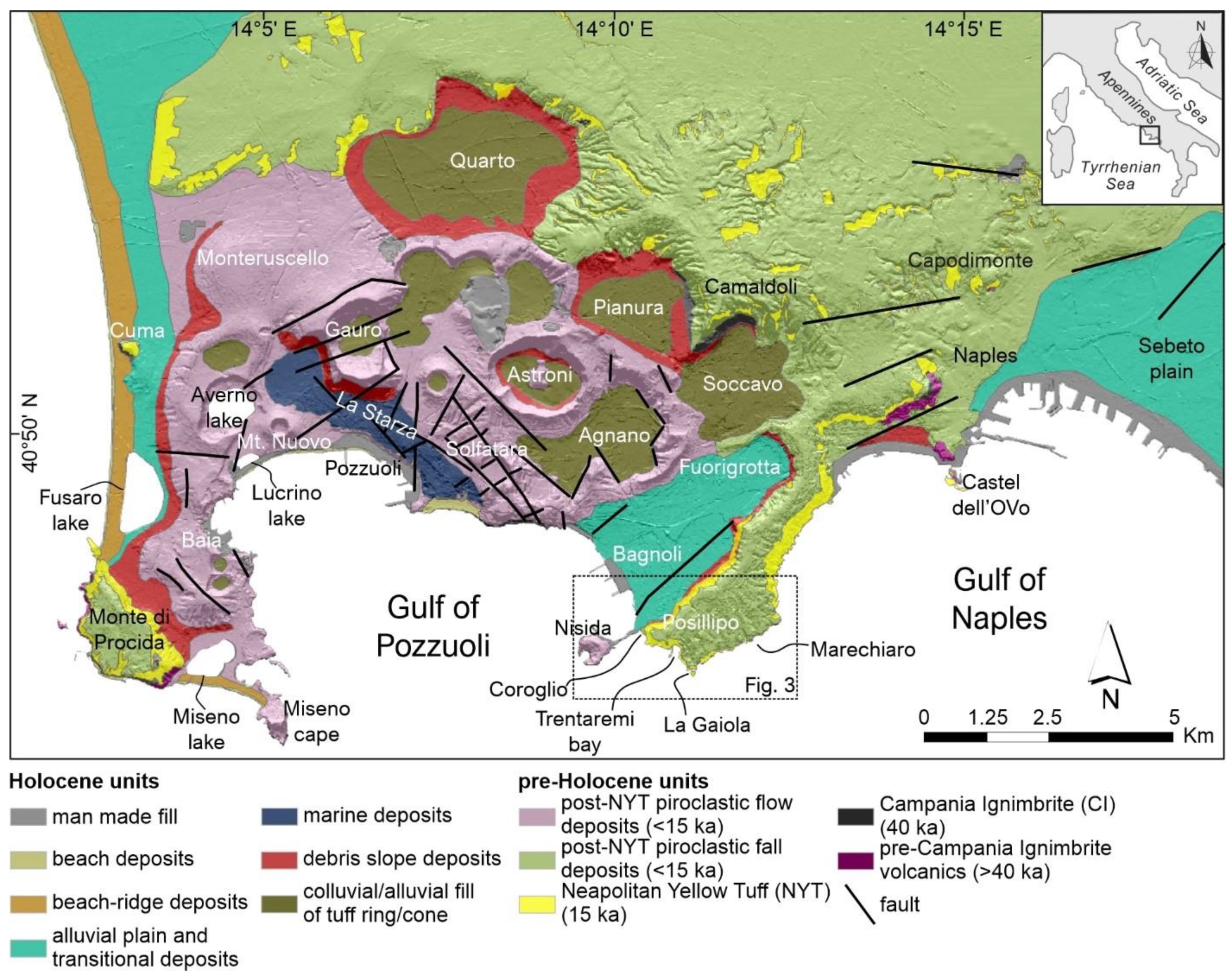Geomorphological Approach to Cliff Instability in Volcanic Slopes: A Case Study from the Gulf of Naples (Southern Italy)
Abstract
1. Introduction
2. Geological and Geomorphological Setting of the Campi Flegrei
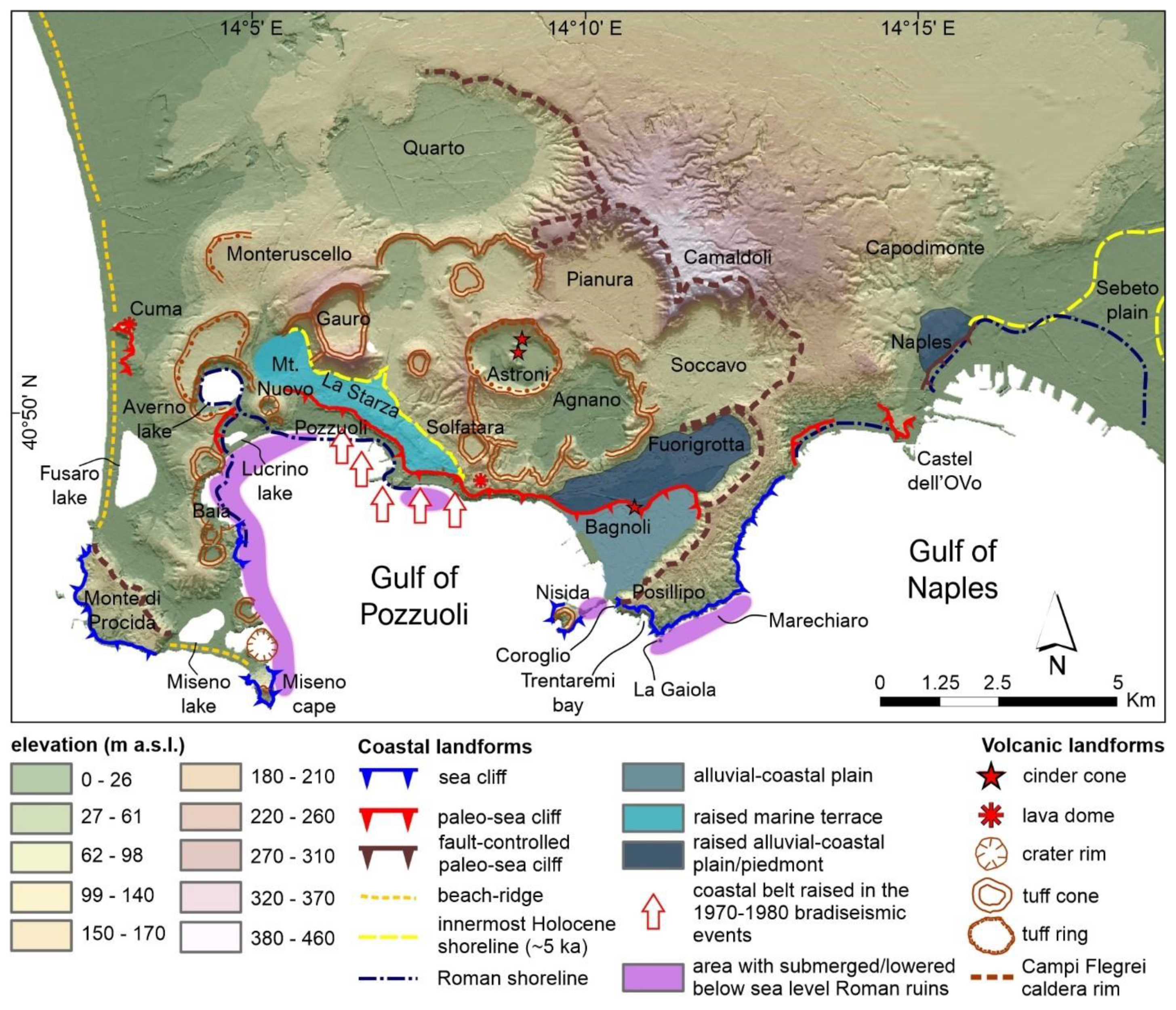
3. Materials and Methods
4. Results
4.1. Geological Setting of the Coroglio-Trentaremi Sea Cliff
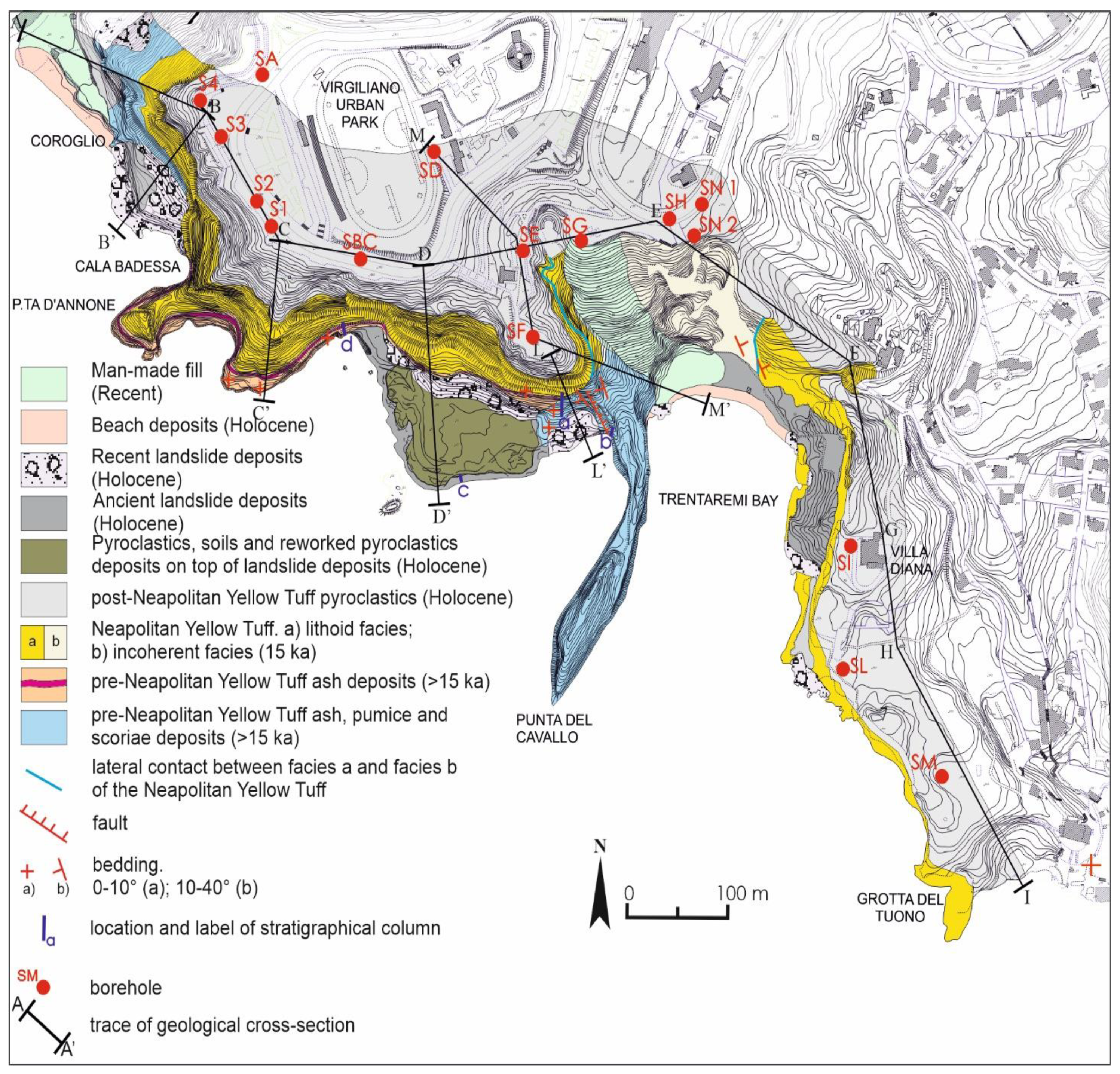

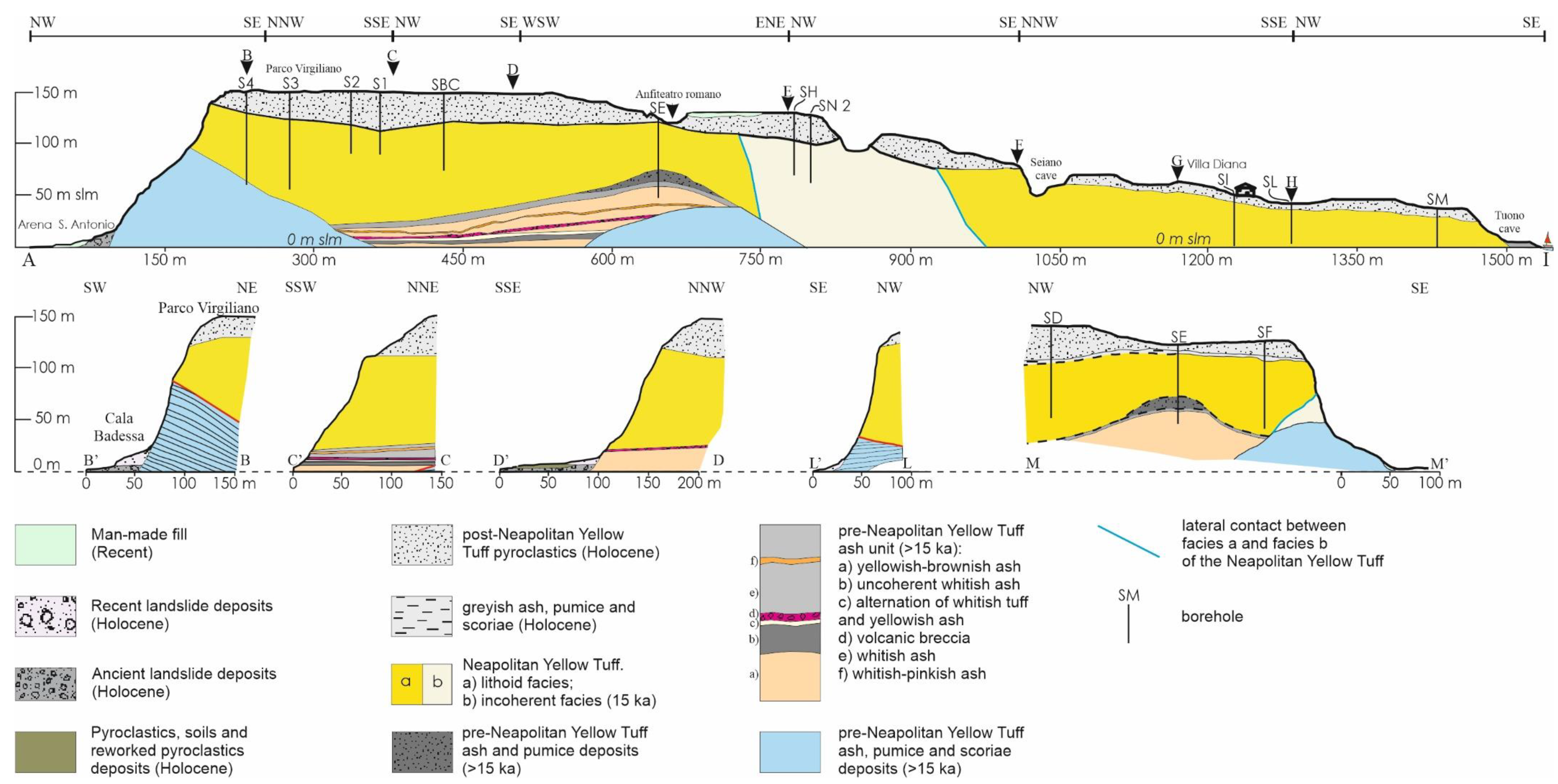
4.2. Geomorphological Setting of the Coroglio-Trentaremi Sea Cliff
4.3. Morphostructural Analysis and Failure Mechanism
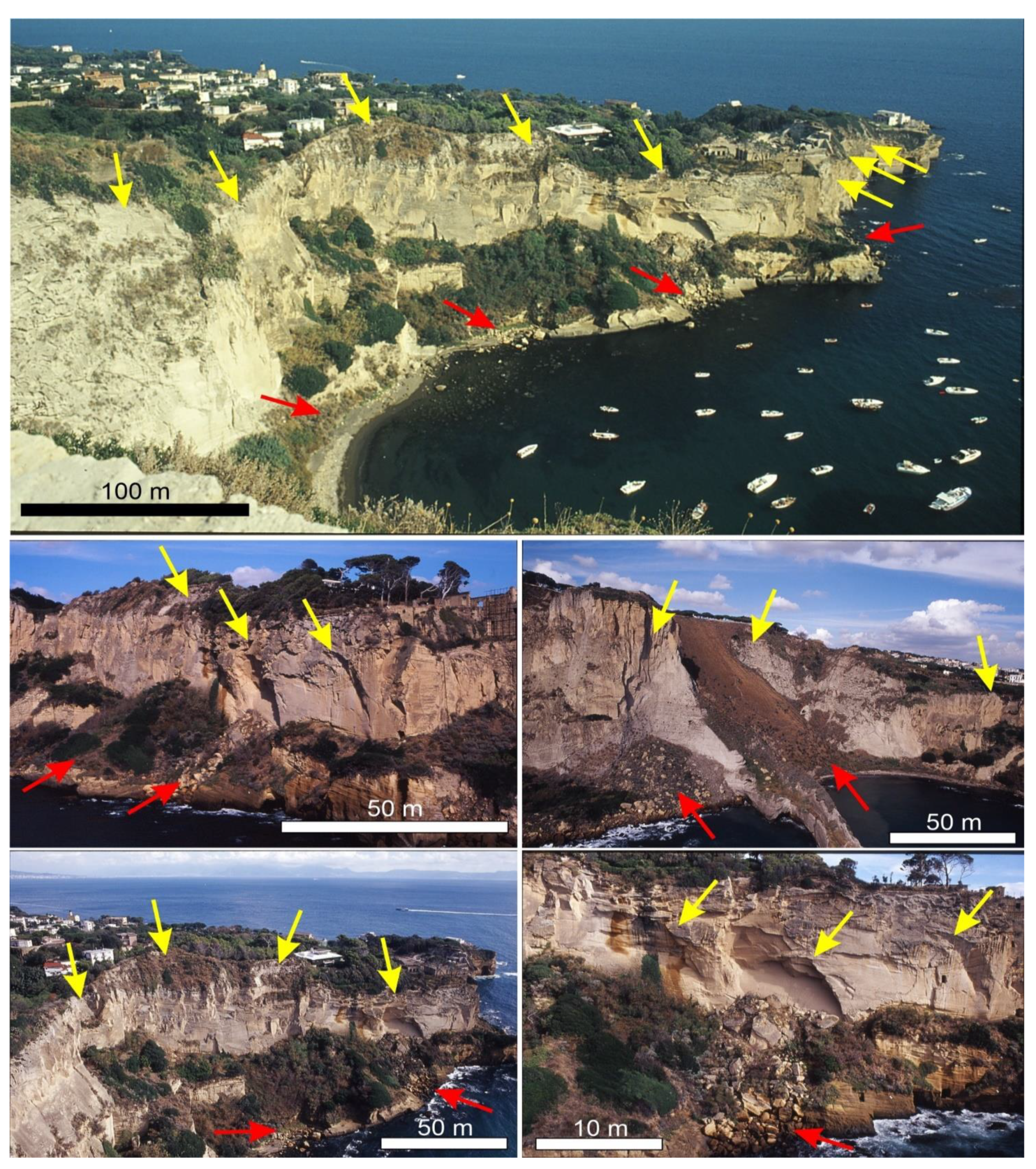
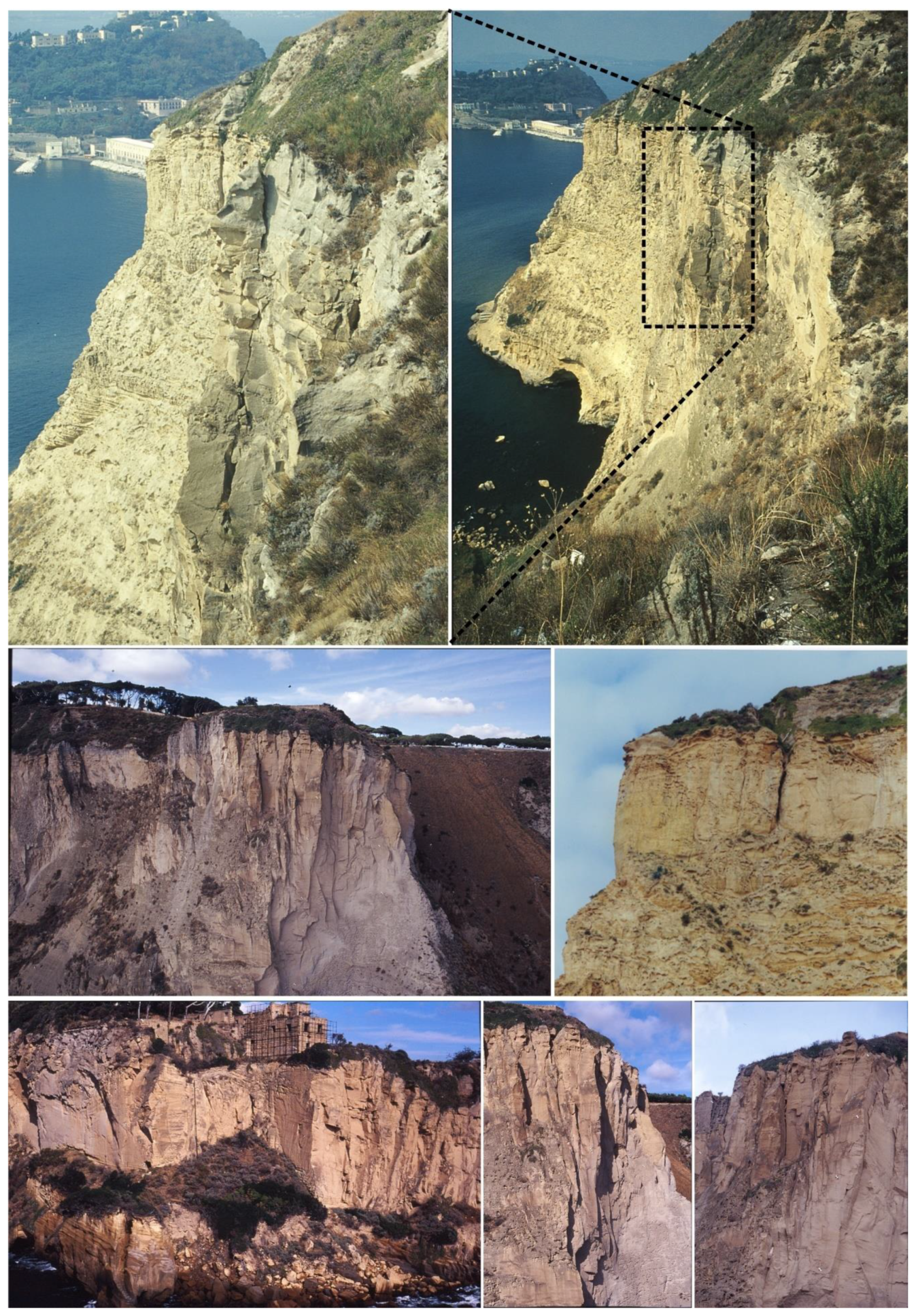
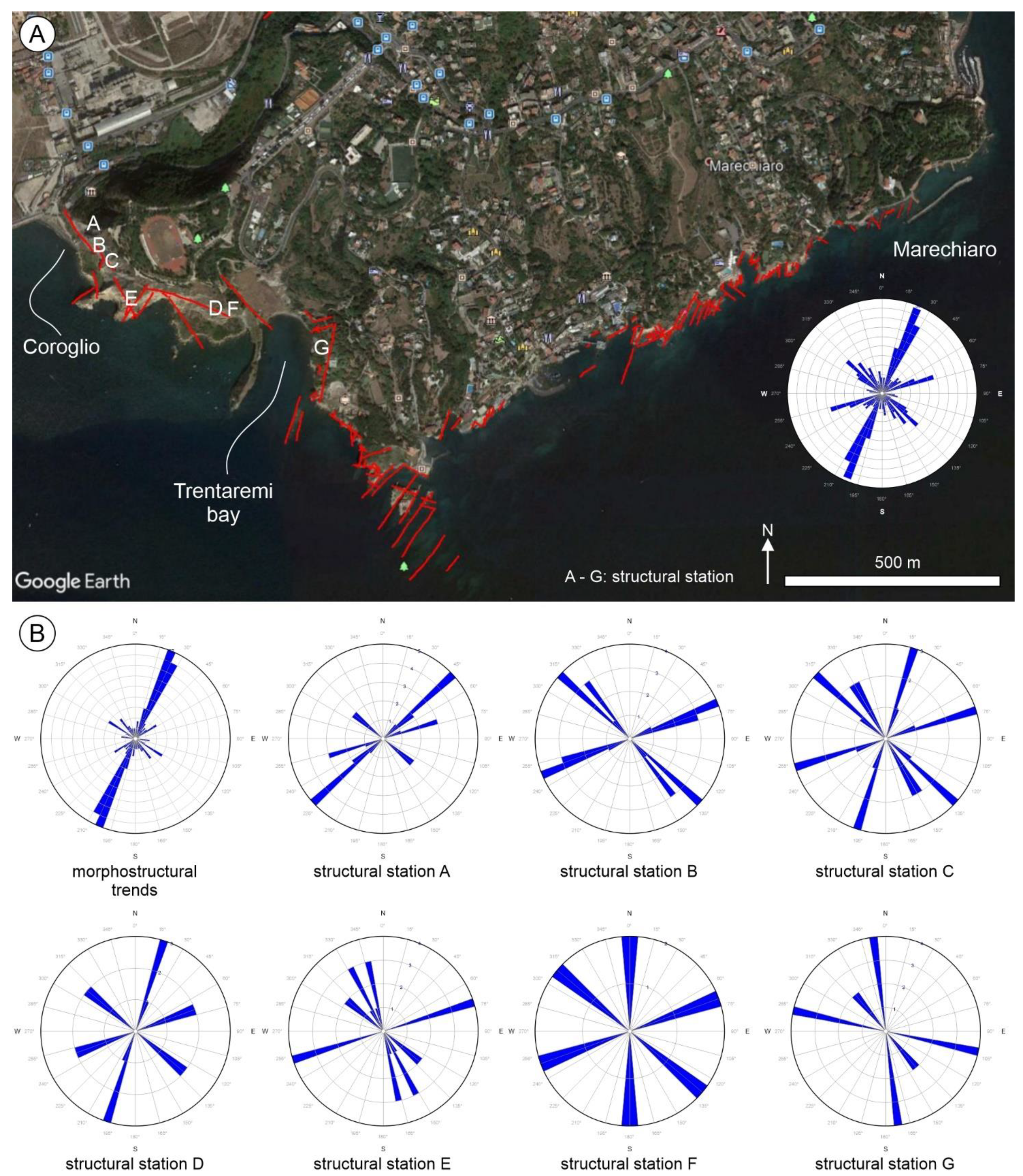
4.4. Geomorphological Zonation of Instability along the Coroglio-Trentaremi Sea Cliff
5. Discussion and Conclusions
Author Contributions
Funding
Acknowledgments
Conflicts of Interest
References
- Walsh, K.; Berger, J.-F.; Roberts, C.N.; Vannière, B.; Ghilardi, M.; Brown, A.G.; Woodbridge, J.; Lespez, L.; Estrany, J.; Glais, A.; et al. Holocene demographic fluctuations, climate and erosion in the Mediterranean: A meta data-analysis. Holocene 2019, 29, 864–885. [Google Scholar] [CrossRef]
- Amato, V.; Cicala, L.; Valente, E.; Ruello, M.R.; Esposito, N.; Ermolli, E.R. Anthropogenic amplification of geomorphic processes along the Mediterranean coasts: A case-study from the Graeco-Roman town of Elea-Velia (Campania, Italy). Geomorphology 2021, 383, 107694. [Google Scholar] [CrossRef]
- Del Río, L.; Gracia, F.J. Erosion risk assessment of active coastal cliffs in temperate environments. Geomorpholohy 2009, 112, 82–95. [Google Scholar] [CrossRef]
- Castedo, R.; Murphy, W.; Lawrence, J.; Paredes, C. A new process—Response coastal recession model of soft rock cliffs. Geomorphology 2012, 177–178, 128–143. [Google Scholar] [CrossRef]
- French, P.W. Coastal Defences; Routledge: London, UK, 2002. [Google Scholar]
- Brooks, S.; Spencer, T. Temporal and spatial variations in recession rates and sediment release from soft rock cliffs, Suffolk coast, UK. Geomorphology 2010, 124, 26–41. [Google Scholar] [CrossRef]
- Young, A.P. Decadal-scale coastal cliff retreat in southern and central California. Geomorphology 2018, 300, 164–175. [Google Scholar] [CrossRef]
- Epifânio, B.; Zêzere, J.L.; Neves, M. Identification of hazardous zones combining cliff retreat rates with landslide susceptibility assessment. J. Coast. Res. 2013, 165, 1681–1686. [Google Scholar] [CrossRef][Green Version]
- Naylor, L.; Stephenson, W. On the role of discontinuities in mediating shore platform erosion. Geomorphology 2010, 114, 89–100. [Google Scholar] [CrossRef]
- Ascione, A.; Aucelli, P.P.; Cinque, A.; Di Paola, G.; Mattei, G.; Ruello, M.; Ermolli, E.R.; Santangelo, N.; Valente, E. Geomorphology of Naples and the Campi Flegrei: Human and natural landscapes in a restless land. J. Maps 2020, 1–11. [Google Scholar] [CrossRef]
- Vitale, S.; Isaia, R. Fractures and faults in volcanic rocks (Campi Flegrei, southern Italy): Insight into volcano-tectonic processes. Acta Diabetol. 2013, 103, 801–819. [Google Scholar] [CrossRef]
- Deino, A.L.; Orsi, G.; de Vita, S.; Piochi, M. The age of the Neapolitan Yellow Tuff caldera-forming eruption (Campi Flegrei caldera—Italy) assessed by 40Ar/39Ar dating method. J. Volcanol. Geotherm. Res. 2004, 133, 157–170. [Google Scholar] [CrossRef]
- Esposito, G.; Salvini, R.; Matano, F.; Sacchi, M.; Danzi, M.; Somma, R.; Troise, C. Multitemporal monitoring of a coastal landslide through SfM-derived point cloud comparison. Photogramm. Rec. 2017, 32, 459–479. [Google Scholar] [CrossRef]
- Aucelli, P.P.; Mattei, G.; Caporizzo, C.; Cinque, A.; Amato, L.; Stefanile, M.; Pappone, G. Multi-proxy analysis of relative sea-level and paleoshoreline changes during the last 2300 years in the Campi Flegrei caldera, Southern Italy. Quat. Int. 2021. [Google Scholar] [CrossRef]
- Aucelli, P.P.C.; Mattei, G.; Caporizzo, C.; Cinque, A.; Troisi, S.; Peluso, F.; Stefanile, M.; Pappone, G. Ancient Coastal Changes Due to Ground Movements and Human Interventions in the Roman Portus Julius (Pozzuoli Gulf, Italy): Results from Photogrammetric and Direct Surveys. Water 2020, 12, 658. [Google Scholar] [CrossRef]
- Matano, F.; Iuliano, S.; Somma, R.; Marino, E.; Del Vecchio, U.; Esposito, G.; Molisso, F.; Scepi, G.; Grimaldi, G.M.; Pignalosa, A.; et al. Geostructure of Coroglio tuff cliff, Naples (Italy) derived from terrestrial laser scanner data. J. Maps 2015, 12, 407–421. [Google Scholar] [CrossRef]
- Mattei, G.; Troisi, S.; Aucelli, P.P.C.; Pappone, G.; Peluso, F.; Stefanile, M. Sensing the Submerged Landscape of Nisida Roman Harbour in the Gulf of Naples from Integrated Measurements on a USV. Water 2018, 10, 1686. [Google Scholar] [CrossRef]
- Matano, F.; Caccavale, M.; Esposito, G.; Fortelli, A.; Scepi, G.; Spano, M.; Sacchi, M. Integrated dataset of deformation measurements in fractured volcanic tuff and meteorological data (Coroglio coastal cliff, Naples, Italy). Earth Syst. Sci. Data 2020, 12, 321–344. [Google Scholar] [CrossRef]
- Aucelli, P.; Cinque, A.; Mattei, G.; Pappone, G.; Stefanile, M. Coastal landscape evolution of Naples (Southern Italy) since the Roman period from archaeological and geomorphological data at Palazzo degli Spiriti site. Quat. Int. 2018, 483, 23–38. [Google Scholar] [CrossRef]
- Fall, M.; Azzam, R.; Noubactep, C. A multi-method approach to study the stability of natural slopes and landslide susceptibility mapping. Eng. Geol. 2006, 82, 241–263. [Google Scholar] [CrossRef]
- Forte, G.; De Falco, M.; Santangelo, N.; Santo, A. Slope Stability in a Multi-Hazard Eruption Scenario (Santorini, Greece). Geosciences 2019, 9, 412. [Google Scholar] [CrossRef]
- Nunes, M.; Ferreira, Ó.; Schaefer, M.; Clifton, J.; Baily, B.; Moura, D.; Loureiro, C. Hazard assessment in rock cliffs at Central Algarve (Portugal): A tool for coastal management. Ocean Coast. Manag. 2009, 52, 506–515. [Google Scholar] [CrossRef]
- Budetta, P.; Santo, A.; Vivenzio, F. Landslide hazard mapping along the coastline of the Cilento region (Italy) by means of a GIS-based parameter rating approach. Geomorphology 2008, 94, 340–352. [Google Scholar] [CrossRef]
- Budetta, P. Stability of an undercut sea-cliff along a Cilento coastal stretch (Campania, Southern Italy). Nat. Hazards 2010, 56, 233–250. [Google Scholar] [CrossRef]
- Budetta, P.; De Luca, C. Wedge failure hazard assessment by means of a probabilistic approach for an unstable sea-cliff. Nat. Hazards 2014, 76, 1219–1239. [Google Scholar] [CrossRef]
- Marques, F.M.S.F.; Matildes, R.; Redweik, P. Sea cliff instability susceptibility at regional scale: A statistically based assessment in the southern Algarve, Portugal. Nat. Hazards Earth Syst. Sci. 2013, 13, 3185–3203. [Google Scholar] [CrossRef]
- Ruberti, D.; Marino, E.; Pignalosa, A.; Romano, P.; Vigliotti, M. Assessment of Tuff Sea Cliff Stability Integrating Geological Surveys and Remote Sensing. Case History from Ventotene Island (Southern Italy). Remote. Sens. 2020, 12, 2006. [Google Scholar] [CrossRef]
- Santangelo, N.; Romano, P.; Ascione, A.; Ermolli, E.R. Quaternary evolution of the Southern Apennines coastal plains: A review. Geol. Carpathica 2017, 68, 43–56. [Google Scholar] [CrossRef]
- Cello, G.; Mazzoli, S. Apennine tectonics in southern Italy: A review. J. Geodyn. 1998, 27, 191–211. [Google Scholar] [CrossRef]
- Turco, E.; Macchiavelli, C.; Mazzoli, S.; Schettino, A.; Pierantoni, P.P. Kinematic evolution of Alpine Corsica in the framework of Mediterranean mountain belts. Tectonophysics 2012, 579, 193–206. [Google Scholar] [CrossRef]
- Doglioni, C.; Innocenti, F.; Morellato, C.; Procaccianti, D.; Scrocca, D. On the Tyrrhenian sea opening. Mem. Descr. Carta Geol. d’Italia 2004, 64, 147–164. [Google Scholar]
- Cinque, A.; Patacca, E.; Scandone, P.; Tozzi, M. Quaternary kinematic evolution of the Southern Appennines. relationships between surface geological features and deep lithospheric structures. Ann. Geophys. 1993, 36, 249–259. [Google Scholar] [CrossRef]
- Brancaccio, L.; Cinque, A.; Romano, P.; Rosskopf, C.; Russo, F.; Santangelo, N.; Santo, A. Geomorphology and neotectonic evolution of a sector of the Tyrrhenian flank of the Southern Apennines (Region of Naples, Italy). Z. Geomorphol. Supp. 1991, 82, 47–58. [Google Scholar]
- Caiazzo, C.; Ascione, A.; Cinque, A. Late Tertiary–Quaternary tectonics of the Southern Apennines (Italy): New evidences from the Tyrrhenian slope. Tectonophysics 2006, 421, 23–51. [Google Scholar] [CrossRef]
- Geological Sheet 447–Napoli of the Geological Map of Italy at scale 1:50000, CARG Project. Available online: https://www.isprambiente.gov.it/Media/carg/447_NAPOLI/Foglio.html (accessed on 20 April 2021).
- Pappalardo, L.; Civetta, L.; D’Antonio, M.; Deino, A.; Di Vito, M.; Orsi, G.; Carandente, A.; de Vita, S.; Isaia, R.; Piochi, M. Chemical and Sr-isotopical evolution of the Phlegraean magmatic system before the Campanian Ignimbrite and the Neapolitan Yellow Tuff eruptions. J. Volcanol. Geotherm. Res. 1999, 91, 141–166. [Google Scholar] [CrossRef]
- De Vivo, B.; Rolandi, G.; Gans, P.B.; Calvert, A.; Bohrson, W.; Spera, F.J.; Belkin, H. New constraints on the pyroclastic eruptive history of the Campanian volcanic Plain (Italy). Miner. Pet. 2001, 73, 47–65. [Google Scholar] [CrossRef]
- Giaccio, B.; Hajdas, I.; Isaia, R.; Deino, A.; Nomade, S. High-precision 14C and 40Ar/39Ar dating of the Campanian Ignimbrite (Y-5) reconciles the time-scales of climatic-cultural processes at 40 ka. Sci. Rep. 2017, 7, srep45940. [Google Scholar] [CrossRef]
- Valente, E.; Buscher, J.T.; Jourdan, F.; Petrosino, P.; Reddy, S.; Tavani, S.; Corradetti, A.; Ascione, A. Constraining mountain front tectonic activity in extensional setting from geomorphology and Quaternary stratigraphy: A case study from the Matese ridge, southern Apennines. Quat. Sci. Rev. 2019, 219, 47–67. [Google Scholar] [CrossRef]
- Fedele, F.G.; Giaccio, B.; Isaia, R.; Orsi, G. The Campanian Ignimbrite Eruption, Heinrich Event 4, and palaeolithic change in Europe: A high-resolution investigation. Large Igneous Prov. 2003, 301–325. [Google Scholar] [CrossRef]
- de Vita, S.; Orsi, G.; Civetta, L.; Carandente, A.; D’Antonio, M.; Deino, A.; di Cesare, T.; Di Vito, M.; Fisher, R.; Isaia, R.; et al. The Agnano–Monte Spina eruption (4100 years BP) in the restless Campi Flegrei caldera (Italy). J. Volcanol. Geotherm. Res. 1999, 91, 269–301. [Google Scholar] [CrossRef]
- Di Renzo, V.; Arienzo, I.; Civetta, L.; D’Antonio, M.; Tonarini, S.; Di Vito, M.; Orsi, G. The magmatic feeding system of the Campi Flegrei caldera: Architecture and temporal evolution. Chem. Geol. 2011, 281, 227–241. [Google Scholar] [CrossRef]
- Di Vito, M.; Isaia, R.; Orsi, G.; Southon, J.; de Vita, S.; D’Antonio, M.; Pappalardo, L.; Piochi, M. Volcanism and deformation since 12,000 years at the Campi Flegrei caldera (Italy). J. Volcanol. Geotherm. Res. 1999, 91, 221–246. [Google Scholar] [CrossRef]
- Smith, V.; Isaia, R.; Pearce, N. Tephrostratigraphy and glass compositions of post-15 kyr Campi Flegrei eruptions: Implications for eruption history and chronostratigraphic markers. Quat. Sci. Rev. 2011, 30, 3638–3660. [Google Scholar] [CrossRef]
- Isaia, R.; Vitale, S.; DI Giuseppe, M.G.; Iannuzzi, E.; Tramparulo, F.D.; Troiano, A. Stratigraphy, structure, and volcano-tectonic evolution of Solfatara maar-diatreme (Campi Flegrei, Italy). GSA Bull. 2015, 127, 1485–1504. [Google Scholar] [CrossRef]
- Liedl, A.; Buono, G.; Lanzafame, G.; Dabagov, S.; Della Ventura, G.; Hampai, D.; Mancini, L.; Marcelli, A.; Pappalardo, L. A 3D imaging textural characterization of pyroclastic products from the 1538 AD Monte Nuovo eruption (Campi Flegrei, Italy). Lithos 2019, 340–341, 316–331. [Google Scholar] [CrossRef]
- Arzilli, F.; Piochi, M.; Mormone, A.; Agostini, C.; Carroll, M.R. Constraining pre-eruptive magma conditions and unrest timescales during the Monte Nuovo eruption (1538 ad; Campi Flegrei, Southern Italy): Integrating textural and CSD results from experimental and natural trachy-phonolites. Bull. Volcanol. 2016, 78, 72. [Google Scholar] [CrossRef]
- Lima, A.; De Vivo, B.; Spera, F.J.; Bodnar, R.J.; Milia, A.; Nunziata, C.; Belkin, H.E.; Cannatelli, C. Thermodynamic model for uplift and deflation episodes (bradyseism) associated with magmatic–hydrothermal activity at the Campi Flegrei (Italy). Earth Sci. Rev. 2009, 97, 44–58. [Google Scholar] [CrossRef]
- Cannatelli, C.; Spera, F.J.; Bodnar, R.J.; Lima, A.; De Vivo, B. Ground movement (bradyseism) in the Campi Flegrei volcanic area. Vesuvius Campi Flegrei Camp. Volcanism 2020, 407–433. [Google Scholar] [CrossRef]
- Cinque, A.; Rolandi, G.; Zamparelli, V. L’estensione dei depositi marini olocenici nei Campi Flegrei in relazione alla vulcano-tettonica. Boll. Soc. Geol. Ital. 1985, 104, 327–348. [Google Scholar]
- Cinque, A.; Aucelli, P.P.C.; Brancaccio, L.; Mele, R.; Milia, A.; Robustelli, G.; Romano, P.; Russo, F.; Santangelo, N.; Sgambati, D. Volcanism, tectonics and recent geomorphological change in the bay of Napoli. Geogr. Fis. Din. Quat. 1997, 3, 123–141. [Google Scholar]
- Morhange, C.; Marriner, N.; Laborel, J.; Todesco, M.; Oberlin, C. Rapid sea-level movements and noneruptive crustal deformations in the Phlegrean Fields caldera, Italy. Geology 2006, 34, 93. [Google Scholar] [CrossRef]
- Del Gaudio, C.; Aquino, I.; Ricciardi, G.; Ricco, C.; Scandone, R. Unrest episodes at Campi Flegrei: A reconstruction of vertical ground movements during 1905–2009. J. Volcanol. Geotherm. Res. 2010, 195, 48–56. [Google Scholar] [CrossRef]
- Isaia, R.; Vitale, S.; Marturano, A.; Aiello, G.; Barra, D.; Ciarcia, S.; Iannuzzi, E.; Tramparulo, F.D. High-resolution geological investigations to reconstruct the long-term ground movements in the last 15 kyr at Campi Flegrei caldera (southern Italy). J. Volcanol. Geotherm. Res. 2019, 385, 143–158. [Google Scholar] [CrossRef]
- Aucelli, P.; Cinque, A.; Mattei, G.; Pappone, G.; Rizzo, A. Studying relative sea level change and correlative adaptation of coastal structures on submerged Roman time ruins nearby Naples (southern Italy). Quat. Int. 2019, 501, 328–348. [Google Scholar] [CrossRef]
- Pappone, G.; Aucelli, P.P.; Mattei, G.; Peluso, F.; Stefanile, M.; Carola, A. A Detailed Reconstruction of the Roman Landscape and the Submerged Archaeological Structure at “Castel dell’Ovo islet” (Naples, Southern Italy). Geosciences 2019, 9, 170. [Google Scholar] [CrossRef]
- Di Martire, D.; De Rosa, M.; Pesce, V.; Santangelo, M.A.; Calcaterra, D. Landslide hazard and land management in high-density urban areas of Campania region, Italy. Nat. Hazards Earth Syst. Sci. 2012, 12, 905–926. [Google Scholar] [CrossRef]
- Wolters, G.; Müller, G. Effect of Cliff Shape on Internal Stresses and Rock Slope Stability. J. Coast. Res. 2008, 241, 43–50. [Google Scholar] [CrossRef]
- Di Crescenzo, G.; Santo, A. Collina di Posillipo e Collina di Camaldoli: Studio Geologico, Geomorfologico e Strutturale; Convenzione di Ricerca CUGRI–Comune di Napoli: Naples, Italy, 2001. [Google Scholar]
- Cole, P.D.; Perrotta, A.; Scarpati, C. The volcanic history of the southwestern part of the city of Naples. Geol. Mag. 1994, 131, 785–799. [Google Scholar] [CrossRef]
- Scarpati, C.; Perrotta, A.; Lepore, S.; Calvert, A. Eruptive history of Neapolitan volcanoes: Constraints from 40Ar–39Ar dating. Geol. Mag. 2012, 150, 412–425. [Google Scholar] [CrossRef]
- Scarpati, C.; Perrotta, A.; Sparice, D. Volcanism in the city of Naples. Rend. Online Soc. Geol. Ital. 2015, 33, 88–91. [Google Scholar] [CrossRef]
- Scarpati, C.; Cole, P.; Perrotta, A. The Neapolitan Yellow Tuff? A large volume multiphase eruption from Campi Flegrei, Southern Italy. Bull. Volcanol. 1993, 55, 343–356. [Google Scholar] [CrossRef]
- Caputo, T.; Marino, E.; Matano, F.; Somma, R.; Troise, C.; De Natale, G. Terrestrial Laser Scanning (TLS) data for the analysis of coastal tuff cliff retreat: Application to Coroglio cliff, Naples, Italy. Ann. Geophys. 2018, 61, 110. [Google Scholar] [CrossRef]
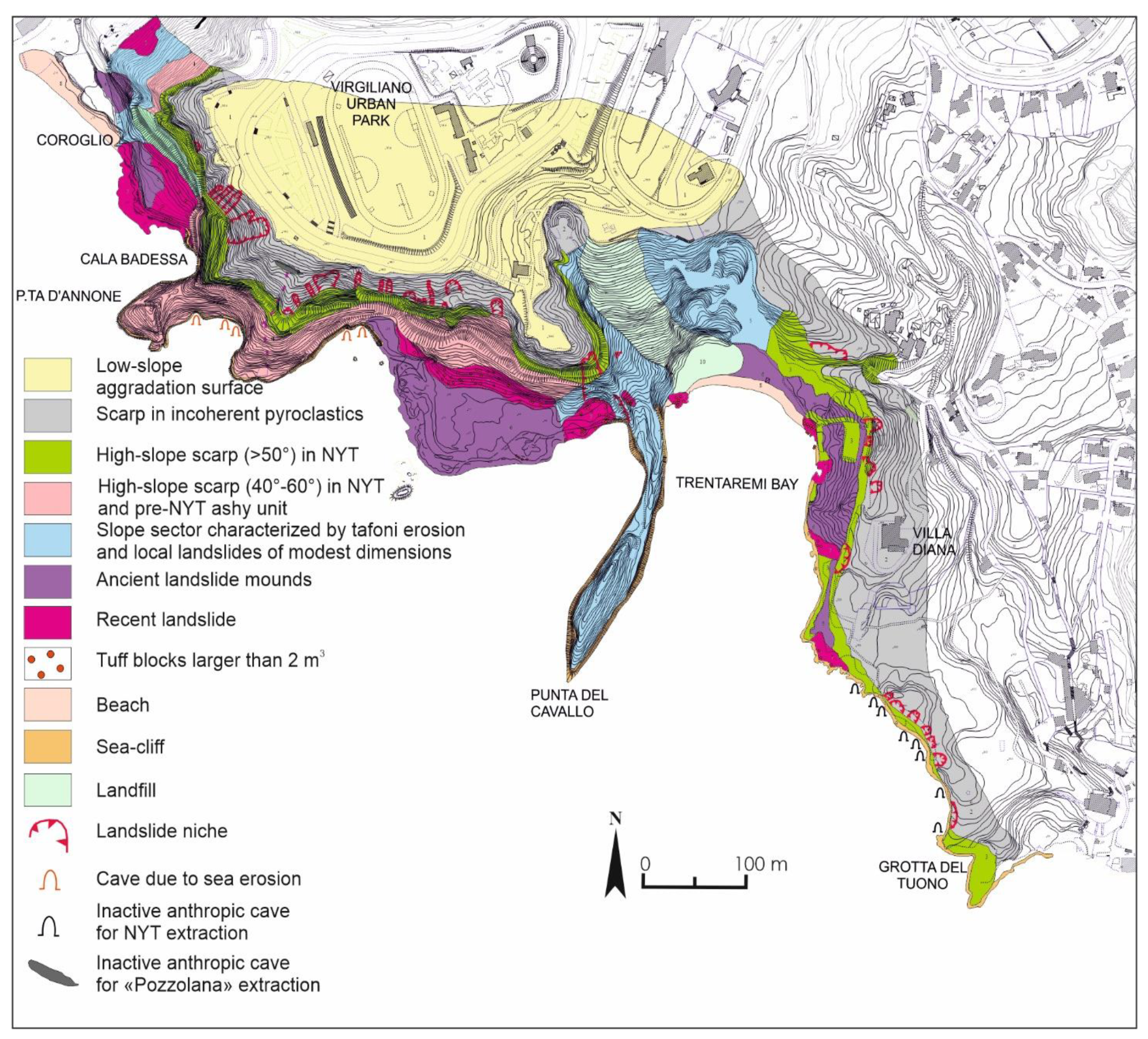
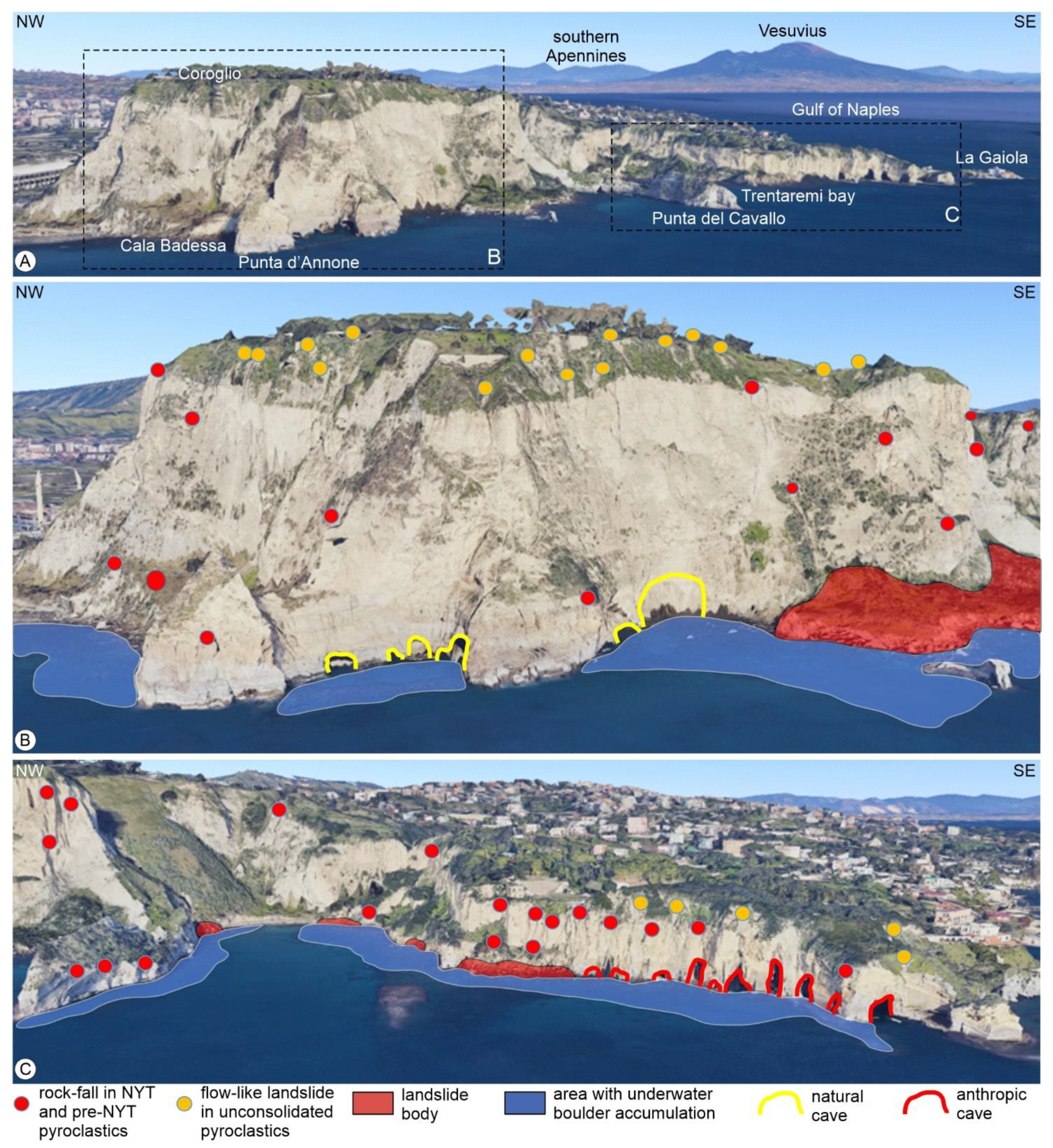


| Weight | I1 Sea Cliff Height (m) | I2 Volume of Landslide Body (m3) | I3 Volume of Detachment Niche (m3) | I4 Volume of Blocks or Projecting Sectors (m3) | W1 Fracture Spacing (m) | W2 Persistence of Beating Fractures (m) | W3 Volume of Caves at the Sea Cliff Base (m3) | W4 Distance between the Shoreline and the Base of Active Sea Cliff (m) |
|---|---|---|---|---|---|---|---|---|
| 1 | 0–20 | 0–10 | 0–100 | 0–5 | >20 | 0–5 | 0 | >20 |
| 2 | 21–100 | 11–30 | 101–300 | 6–10 | 10–19 | 6–10 | 1–20 | 11–20 |
| 3 | 100–200 | 31–50 | 301–1000 | 11–30 | 5–9 | 11–30 | 21–100 | 2–10 |
| 4 | >200 | >50 | >1000 | >30 | 0–4 | >30 | 101–1000 | 0–1 |
| Weight of Intensity Factor | 1 | 2 | 3 | 4 | |
|---|---|---|---|---|---|
| Weight of Weakness Factor | |||||
| 1 | M3 | M3 | M2 | M2 | |
| 2 | M3 | M3 | M2 | M1 | |
| 3 | M2 | M2 | M2 | M1 | |
| 4 | M1 | M1 | M1 | M1 | |
| Structural Station A | α | β | Structural Station B | α | β |
| K1 | 310 | 85 | K1 | 310 | 85 |
| K2 | 250 | 85 | K2 | 250 | 85 |
| K3 | 45 | 85 | K4 | 140 | 70 |
| Ks | 200 | 20 | Ks | 200 | 20 |
| sea cliff front | 230 | 85 | sea cliff front | 245 | 85 |
| Structural Station C | α | β | Structural Station D | α | β |
| K1 | 310 | 85 | K1 | 310 | 85 |
| K2 | 250 | 85 | K2 | 250 | 85 |
| K5 | 330 | 70 | Ks | 200 | 20 |
| Ks | 330 | 70 | sea cliff front | 200 | 80 |
| sea cliff front | 200 | 20 | |||
| Structural Station E | α | β | Structural Station F | α | β |
| K1 | 310 | 85 | K1 | 310 | 85 |
| K2 | 250 | 85 | K2 | 250 | 85 |
| K5 | 330 | 70 | Ks | 200 | 20 |
| Ks | 200 | 20 | sea cliff front | 180 | 85 |
| sea cliff front | 165 | 80 | |||
| Structural Station G | α | β | |||
| K4 | 140 | 70 | |||
| K5 | 175 | 65 | |||
| Ks | 200 | 20 | |||
| sea cliff front | 280 | 85 | |||
| Structural Station | Fractures’ System | Proposed Failure Mechanism |
|---|---|---|
| A | K1-K2-K3-Ks | Toppling |
| B | K1-K2-K4-Ks | Toppling |
| C | K1-K2-K5-Ks | Wedge breaks and planar slide |
| D | K1-k2-Ks | Rock-fall |
| E | K1-K2-K5-Ks | Rock-fall and toppling |
| F | K1-K2-Ks | Rock-fall and toppling |
| G | K4-K5-Ks | Wedge break |
Publisher’s Note: MDPI stays neutral with regard to jurisdictional claims in published maps and institutional affiliations. |
© 2021 by the authors. Licensee MDPI, Basel, Switzerland. This article is an open access article distributed under the terms and conditions of the Creative Commons Attribution (CC BY) license (https://creativecommons.org/licenses/by/4.0/).
Share and Cite
Di Crescenzo, G.; Santangelo, N.; Santo, A.; Valente, E. Geomorphological Approach to Cliff Instability in Volcanic Slopes: A Case Study from the Gulf of Naples (Southern Italy). Geosciences 2021, 11, 289. https://doi.org/10.3390/geosciences11070289
Di Crescenzo G, Santangelo N, Santo A, Valente E. Geomorphological Approach to Cliff Instability in Volcanic Slopes: A Case Study from the Gulf of Naples (Southern Italy). Geosciences. 2021; 11(7):289. https://doi.org/10.3390/geosciences11070289
Chicago/Turabian StyleDi Crescenzo, Giuseppe, Nicoletta Santangelo, Antonio Santo, and Ettore Valente. 2021. "Geomorphological Approach to Cliff Instability in Volcanic Slopes: A Case Study from the Gulf of Naples (Southern Italy)" Geosciences 11, no. 7: 289. https://doi.org/10.3390/geosciences11070289
APA StyleDi Crescenzo, G., Santangelo, N., Santo, A., & Valente, E. (2021). Geomorphological Approach to Cliff Instability in Volcanic Slopes: A Case Study from the Gulf of Naples (Southern Italy). Geosciences, 11(7), 289. https://doi.org/10.3390/geosciences11070289







